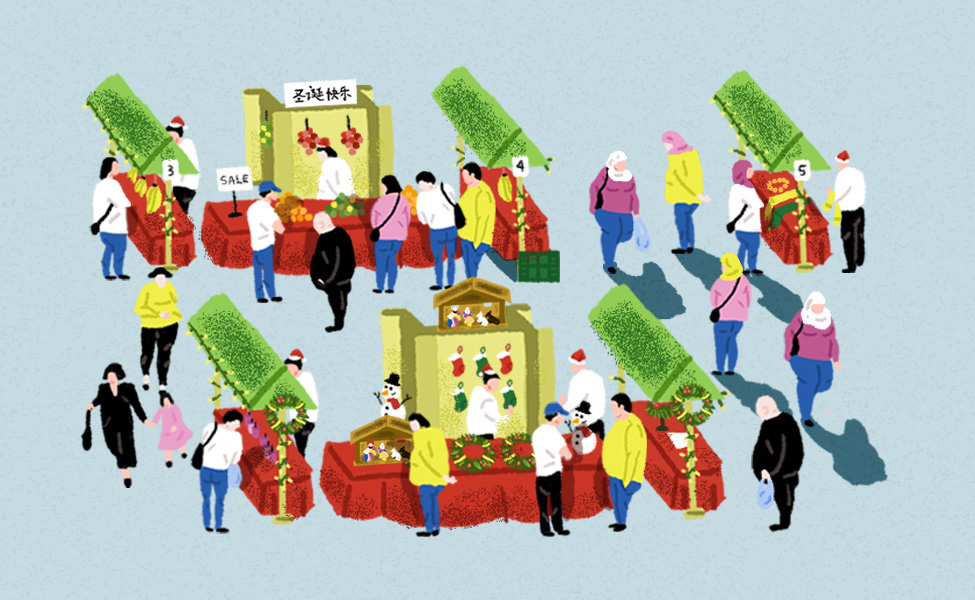As much as Christmas is a commercial holiday that pervades Filipino culture through media and society, it is primarily a deeply spiritual time when more than half of its festivities are religious celebrations of feast days, masses, and festivals. Because the Philippines is a largely Catholic country, practices of other major cultural groups such as the Chinese and Muslim often go unrepresented in lieu of the more general, Catholic understanding of the celebration. In an effort to broaden our perspective on the festivities that happen during December, Vantage delves into the Catholic, Chinese, and Muslim sectors for their ways of understanding and celebrating Christmas.
Catholic: A Spanish conquest
According to culture writer Reynaldo Alejandro as well as journalist and novelist Maria Chorengel, the first official nativity mass in the Philippines was celebrated in 1565. Since then, many practices have been passed down by Spanish missionaries and have evolved into traditions that have become inherently Filipino.
One of these traditions is the use of the bright, five-pointed star lantern called the parol as a staple Christmas decoration. In their book, Pasko!: A Philippine Christmas, Alejandro and Chorengel share that at times, a tassel tail or two is added to two adjacent ends of the star because people believe that the Star of Bethlehem was a comet. Although it is now seen as a Christmas decoration, it was originally used to guide Filipino Catholics during dawn to the celebration of the Misa de Gallo.
The Misa de Gallo or the “mass of the rooster,” are dawn masses celebrated for nine consecutive days starting from December 16. According to Chorengel and Alejandro, the Misa de Gallo was inspired by a Spanish friar who took advantage of the fact that Christmas coincided with the harvest season, and thought that the natives could easily be encouraged to participate in worship before work.
Christmas in the Catholic perspective is mostly celebrated through decorative lights, prayer and the celebration and remembrance of the significant events that led to the birth of Jesus as written in the Bible.
Chinese: A multi-faith Christmas
The Chinese do not really celebrate Christmas religiously; the real pomp and grandeur of their festivities is saved for the New Year, a bigger and more important holiday for the Chinese as it brings in new prosperity and luck for the coming year.
Third generation Chinese-Filipino Richard Milante, a senior management engineering student, shares his experiences of seeing Christian and Buddhist practices mixed into the holiday with his Catholic mother and Buddhist father: “There is [still] the tree, the gifts, and the mass—the practices are very Christian. I’m Catholic, [so] we talk to God, but we also pray to ancestors and guardians like Luck, Prosperity, and Happiness.”
Milante adds that round fruits in particular signify wealth and are offered to ancestors. “We have to offer [the fruits] beside [the ancestors] and then you have to wear polka dots because roundness symbolizes] coins or money.”
Even though Milante comes from a predominantly Chinese family, he shares that neither he nor his generations of relatives who have migrated to the Philippines feel under-represented when it comes to Christmas. “In the first place, we don’t really have a Christmas for Chinese so it’s something we’ve adopted.”
Muslim: Eid al-Fitr and Eid al-Adha
According to Muslim doctrine, Muslims are prohibited from taking part in celebrations other than their own to hold on to their religious identity. In the place of Christmas, Muslims celebrate two main religious festivals each year called Eid al-Adha and Eid al-Fitr that are celebrated between July and September. While they celebrate different things (the former commemorates Abraham’s willingness to sacrifice his son Ishmael and the latter marks the end of Ramadan’s fasting) both festivals entail big feasts, merrymaking, and some gift-giving.
Complications arise when these holidays are moved in lieu of the Catholic majority. Senior Ameera Tungupon sheds some light on what it’s like being a Filipino Muslim in a country that favors long weekends over religious sensitivity. “Namomove talaga ‘yung Eid kase we follow the lunar calendar, [but] it [still] kinda comes off [as] disrespectful (The Eid really gets moved since we follow the lunar calendar, but it still comes off as disrespectful),” she says.
Tungupon raises the issue of the fasting schedule as both Eids entail fasting as the official dates are announced only on the day before the actual event. As they are so often moved by the government, Muslims have to rearrange their schedule and plan their meals. “For both of [the festivals], magfafasting ka dapat before. For example, it’s Wednesday, tapos sabihin na, Eid al Fitr na sa Thursday, that means I don’t have to fast na tomorrow. Pero if you’re going to say it’s actually on a Friday, I have to fast one more day (For both of the festivals, you have to fast beforehand. For example, it’s Wednesday and it is announced that it’s Eid al Fitr on Thursday which means I don’t have to fast anymore tomorrow. But if you say it’s actually on a Friday, I have to fast one more day).”
It calls to attention questions of equality, says Tungupon. “How can you say [that Muslims are of equal footing with everyone else] when you can’t even celebrate your holiday with everyone else [other Muslims]?” she asks. “You [may be] a minority but you should be respected despite the fact na konti lang kayo (You may be a minority but you should be respected despite the fact you are only a few).”
Festivities for all
The diversity of the Philippines makes Christmas an avenue for these groups to create their own traditions that enrich the Filipino Christmas culture as a whole, while still paying homage to each group’s individuality. Conversely, this may make other groups—such as the Muslims—feel left out and forgotten because of how differently we perceive their holidays. Aside from being a time for merrymaking, Christmas also serves as a reminder that there are many more existing groups in our society whose celebrations should be highly regarded and respected just the same.






